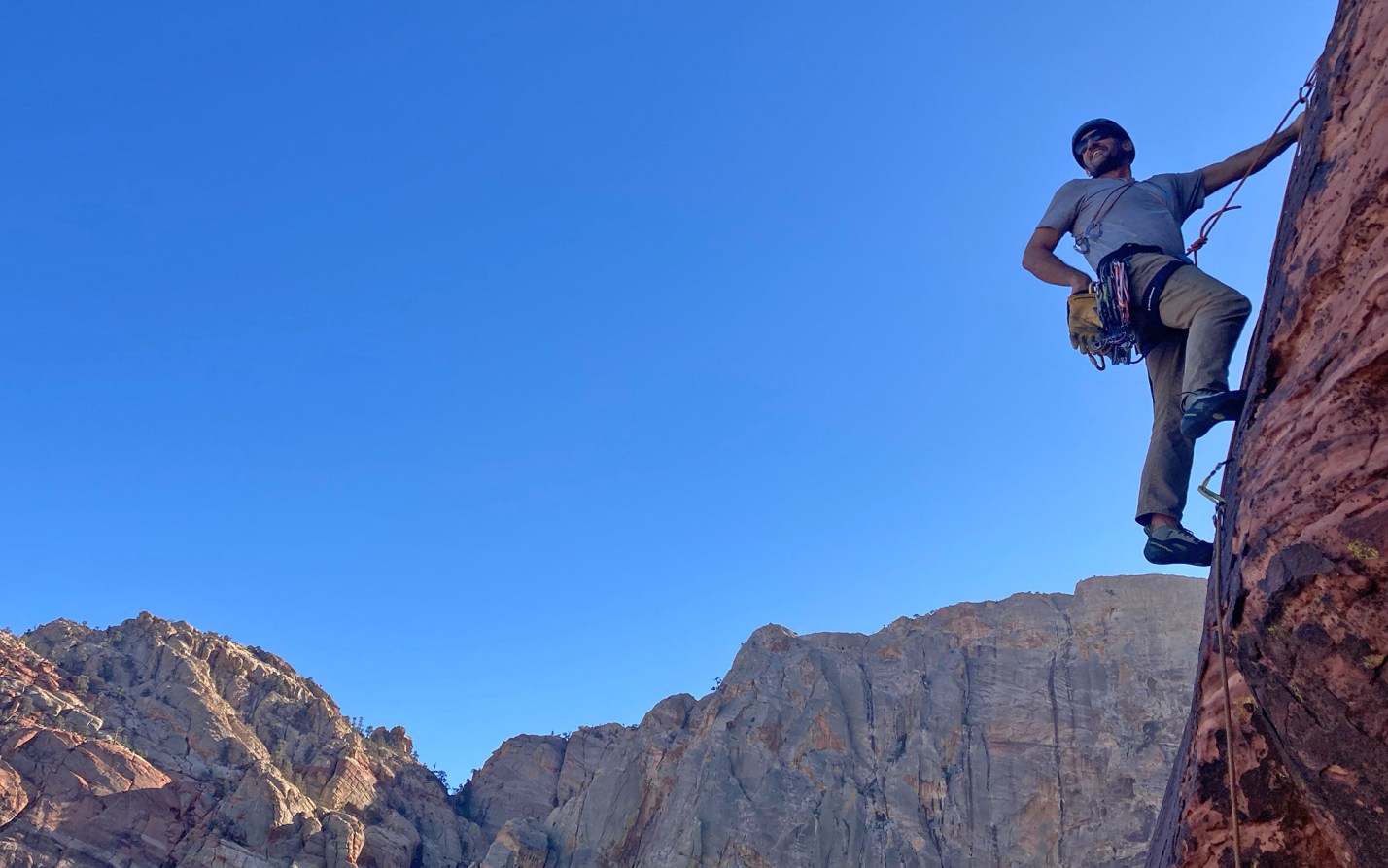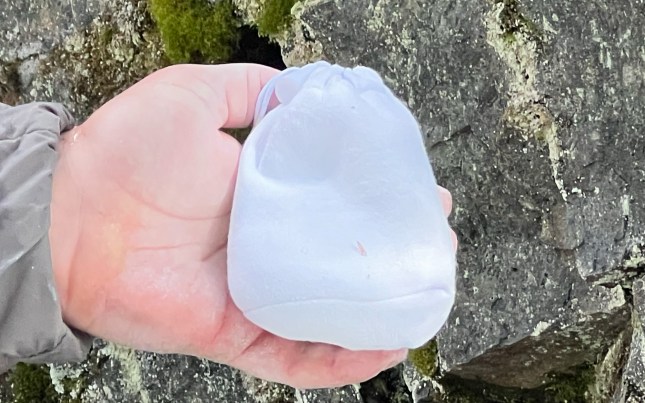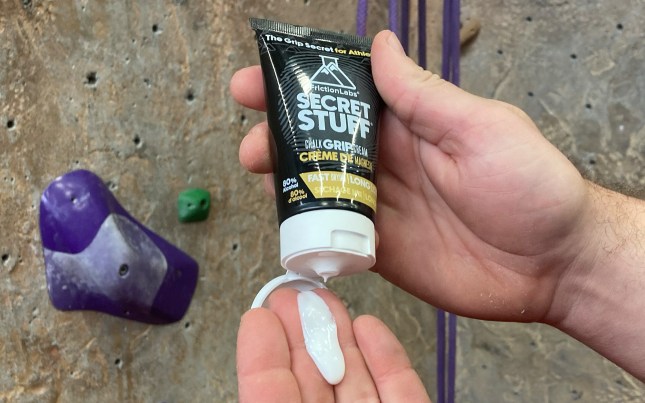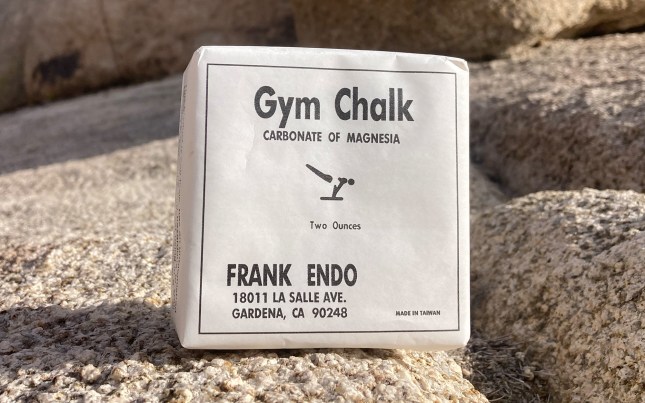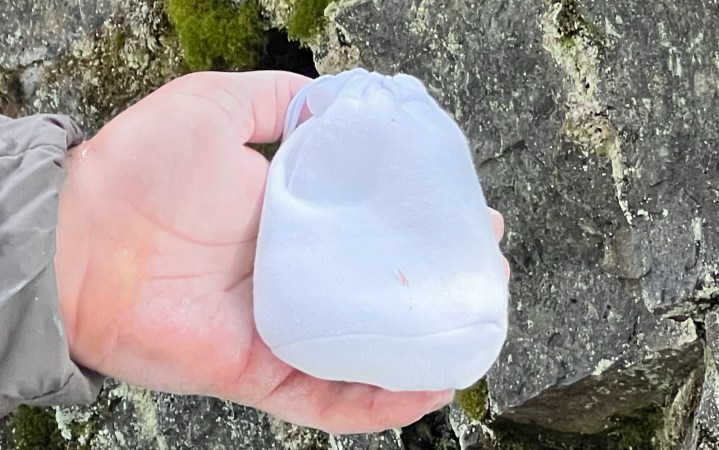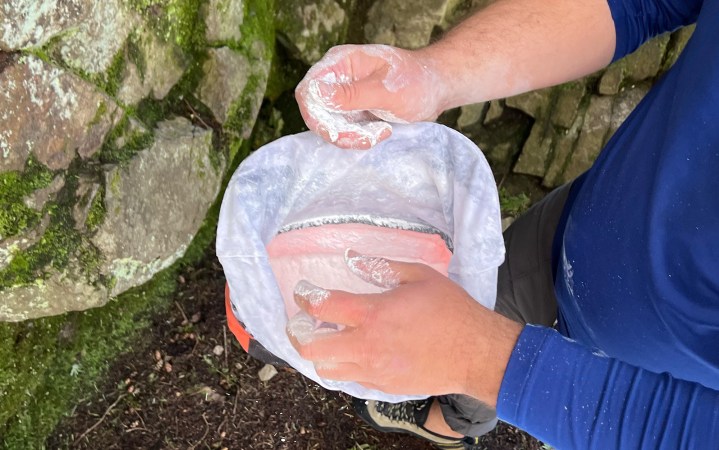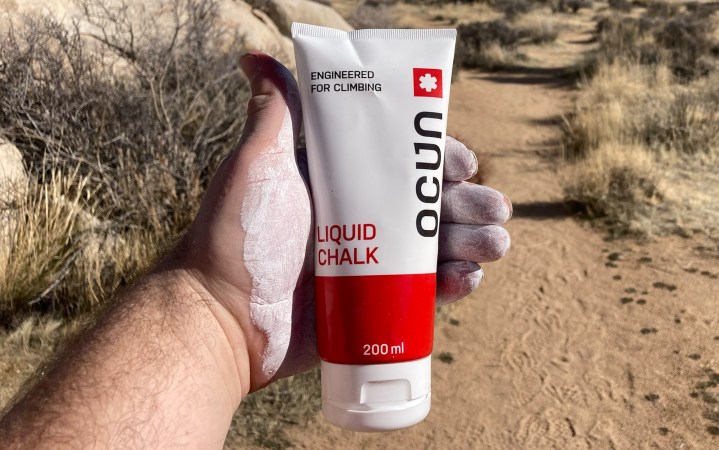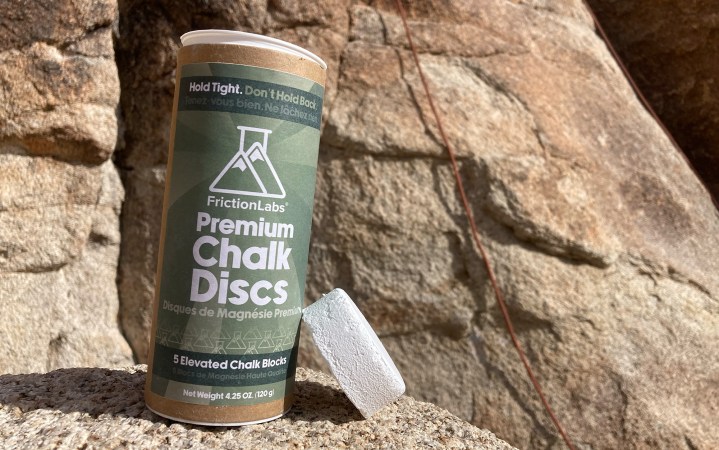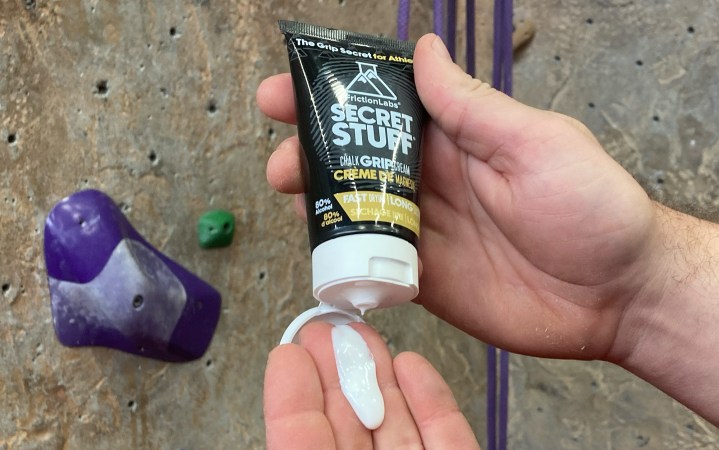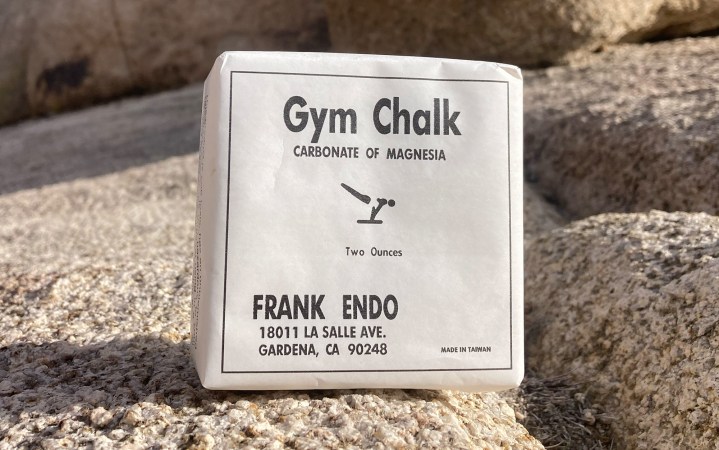We may earn revenue from the products available on this page and participate in affiliate programs. Learn More ›
Climbers use chalk to keep their skin dry and increase friction at the point of contact with the rock. The practice was adopted from the gymnastics and weightlifting world where sweaty hands can lead to poor performance. Given the similarities there, climbers realized the benefit of using chalk when pushing free climbing grades and holding on to tiny rock edges.
While there are all kinds of bizarre and questionable practices to reduce sweating found in the dark corners of online climbing forums (I once knew someone who used a setup that included batteries and a bowl of water), chalk is by far the simplest and most popular method for drying out your skin while climbing. The modern boom in climbing popularity has also brought with it all kinds of variations in chalk styles, application methods, and formulas. This has added some complexity and sometimes even confusion for folks looking to purchase something that seems like it should be pretty straightforward. In this review I sort out some of the best climbing chalks on the market and their best uses for each type of chalk.
- Best Overall: Metolius Refillable Super Chalk Sock
- Best Loose: Friction Labs Unicorn Dust
- Best Liquid: Ocun Liquid Chalk
- Best Block: Friction Labs Chalk Disks
- Best for the Gym: Friction Labs Secret Stuff Hygienic
- Best Budget: Frank Endo Block Chalk
How I Tested the Best Climbing Chalk
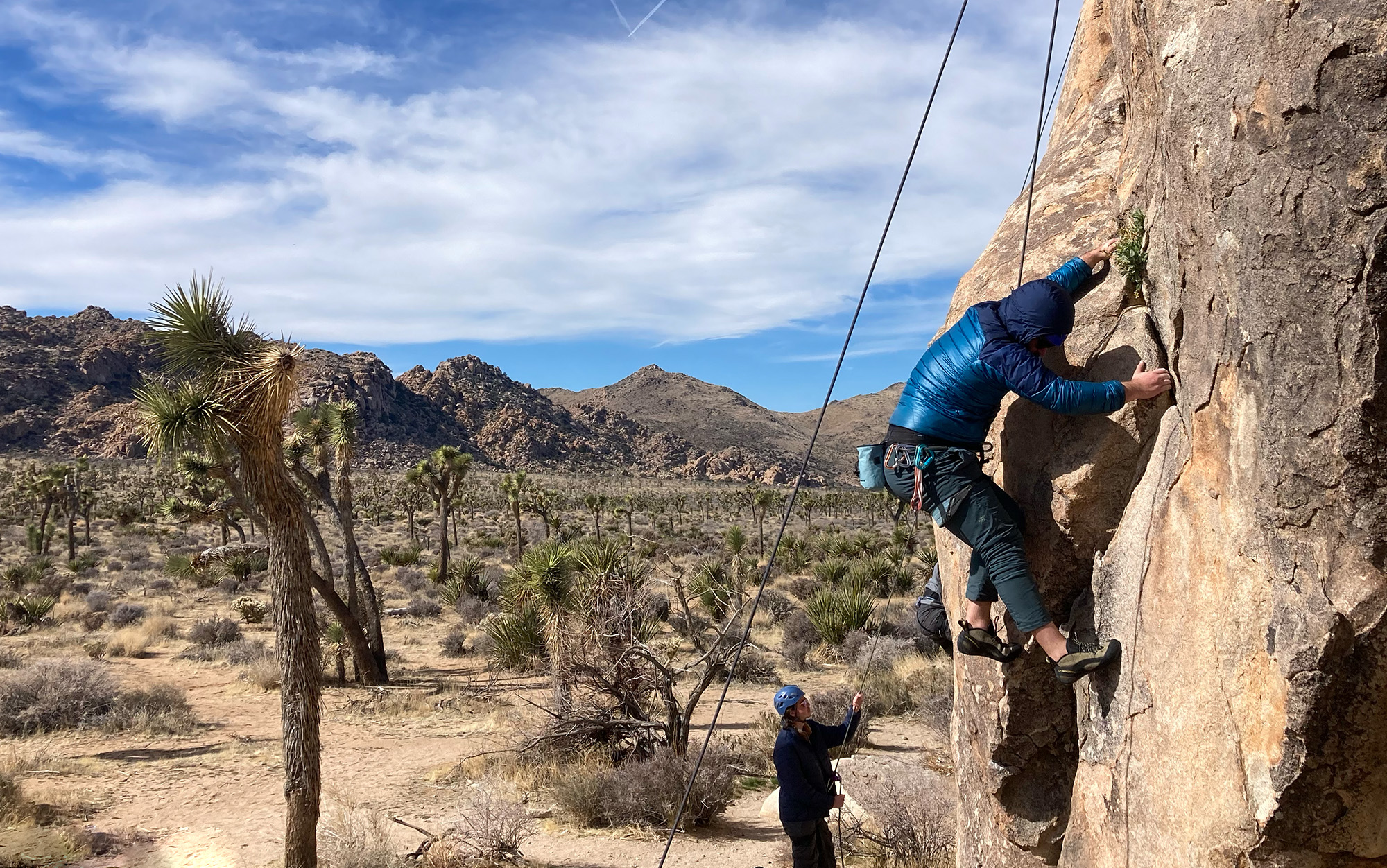
Sean McNally
I have been rock climbing now for over 20 years, and love all kinds of climbing. Every time I put on my rock shoes, I use chalk. I tested the best climbing chalks while gym climbing, bouldering, sport climbing, crack climbing, and multi-pitch climbing. The surfaces ranged from grubby plastic holds to high friction granite, to smooth sandstone and limestone. I used the best climbing chalks on hot, soupy days in the summer as well as fingertip numbing cold days in the winter.
The aspects I considered in testing were price, application method, and how long the chalk lasted before I felt I needed to reapply. I tested this last metric by using a Treadwall in the gym with a timer and tracking how often I chalked up during a 20 minute session. After all those pitches and holds, I hope to bring some clarity to which chalk is best for different types of climbing and settings.
Best Climbing Chalks: Reviews & Recommendations
Best Overall: Metolius Refillable Super Chalk Sock
Key Features
- Chalk is inside a “sock” or cloth bag
- Sock is refillable
- 1.1 ounces
- Price: $5
Pros
- Sock is refillable so you can reuse multiple times
- Sock gives you something to grab with your hands
- Can chalk the back of your hands
- Sock reduces the amount of dust in the air
- Very affordable
Cons
- Less precise chalking than a block
- Less chalk gets on your hands than loose chalk, requiring more frequent chalk ups
Metolius’s Refillable Super Chalk Sock is my go-to chalk. It’s affordable and it does whatever I need it to do no matter what kind of climbing I’m doing. The sock reduces dust in the air so most gyms will allow it indoors and you have less cleaning to do if you use it climbing on a home wall. The design also reduces waste since the chalk doesn’t all dump out on the ground if you tip your chalk bag over.
When outside, I can leave it in a chalk bag on the ground and dust my hands in between attempts on a short boulder problem or keep it in a chalk bag on my back for all-day vertical outings. I do find that I need to chalk up a little more often when using a chalk sock (about every minute or so) which is likely because the chalk has to pass through some cloth before it is applied to my hands.
The versatility of a chalk sock is also nice for performance, as you can squeeze the sock to coat your palms. For crack climbing, which requires jamming your hands into cracks, you can take the sock out entirely and pat down the back of your hands and wrists. While some climbers like to be more precise with where and how much chalk gets applied to their hands and fingers, the Chalk Sock will be more than adequate for most on any kind of climbing adventure. And it’s just under $5 a sock, which you can refill again and again.
Best Loose: Friction Labs Unicorn Dust
Key Features
- Loose chalk
- 10 ounces
- $25
Pros
- Feels really smooth
- Stays on the skin longer
- Loose chalk allows you to get a lot of chalk on your skin fast
- Responsibly sourced and made in the USA
Cons
- Expensive
- Creates a lot of chalk dust in the air
As the name would imply, it seems that Friction Labs has chalk down to a science. The company claims that after testing other brands, they found their products contain higher percentages of magnesium carbonate (chalk). However, the other brands I looked at didn’t list anything other than magnesium carbonate in their products. Now, I don’t have access to a lab, and I’m no scientist so I wouldn’t know how to read the test results anyway. But I have been using climbing chalk for a long time and I was a bit skeptical there would be a noticeable difference. Turns out, Friction Labs’ chalk does feel really really good. It’s soft and silky and lasted longer on my skin than other chalk. I climbed on a Treadwall for over three minutes before needing to chalk up again (for me that’s a very long time because my hands get sweaty).
The Unicorn Dust is the finest grain loose chalk they sell (there are other consistencies available) so you can get the coating on your hands just right. But it does produce a lot of dust in the air and can spill easily. I found it was best used in a big chalk bucket while bouldering or in a chalk bag on single pitch climbs. This chalk is also expensive so it may take a dent out of your climbing budget. If you can afford it, Friction Labs produces chalk that will make you feel like you’re climbing at your best.
Best Liquid: Ocun Liquid Chalk
Key Features
- Liquid chalk
- 200ml tube
- $15
Pros
- Largest tube I could find
- Liquid chalk lasts longest on the skin
- No chalk dust in the air when applying
- Cheaper than other liquid chalk brands
Cons
- Liquid chalk can’t be reapplied while climbing
- Not as portable as other chalk
- More waste since you have to throw out the tube when you’re done
I remember being amazed when I first tried liquid chalk. You squeeze out a blob of what looks like Elmer’s Glue on your hands and rub it around. Thirty seconds to a minute later, your hand is covered with a neat film of dry chalk. It seems like magical stuff. Now liquid chalk is a staple at rock gyms and indoor home walls because it doesn’t add a bunch of chalk to the air. The chalk also lasts a really long time on your skin so it has become very popular with climbers as a base or first layer of chalk, and then reapplication comes from the chalk in your chalk bag while you climb. I found that I could climb over five minutes without needing to chalk up after applying a layer of Ocun liquid chalk.
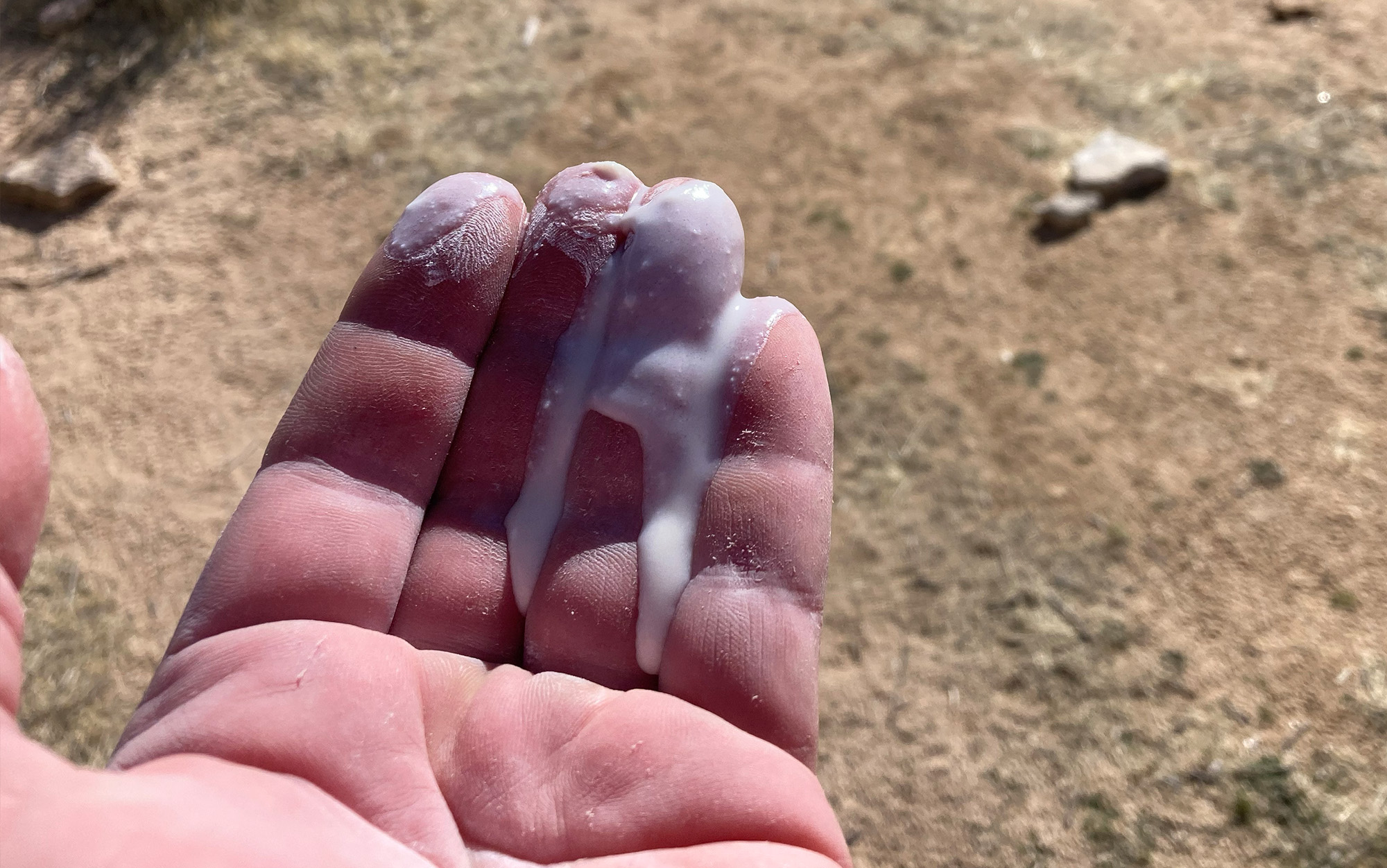
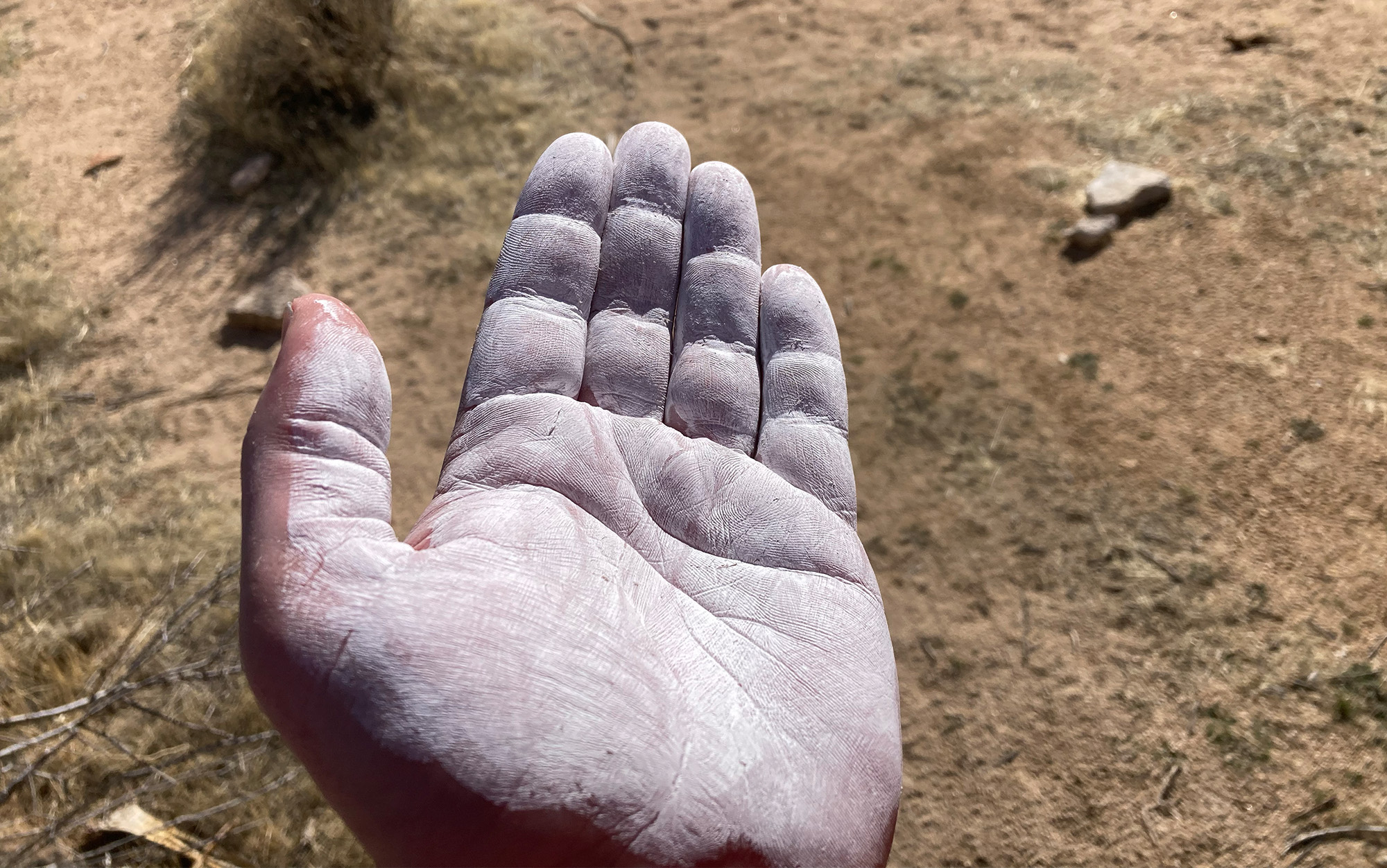
The Ocun liquid chalk is a good price and comes in a larger tube than many of the other brands. I like this because I found myself constantly buying new tubes of liquid chalk and it was a bit like buying new tubes of travel sized toothpaste. They never last as long as you want them to. The biggest limitation with liquid chalk is that it takes two hands to apply and some time to dry out so it’s very impractical if not downright impossible to apply mid-climb.
Best Block: Friction Labs Chalk Disks
Key Features
- Five 0.85-ounce discs
- $15
Pros
- Discs are smaller than other blocks so they travel better
- Resistant to crumbling
- Little to no chalk dust in the air when applying
Cons
- Expensive
- Can’t reapply mid climb
Solid chalk blocks have become very popular with boulderers and hard sport climbers because you can rub your hands or fingers on the solid surface to precisely apply the chalk exactly where you want it. Other blocks are pretty large so climbers can crunch up part of it into loose chalk and put it in a chalk bag, but Friction Labs created a product primarily for those who are going to use it in its solid form.
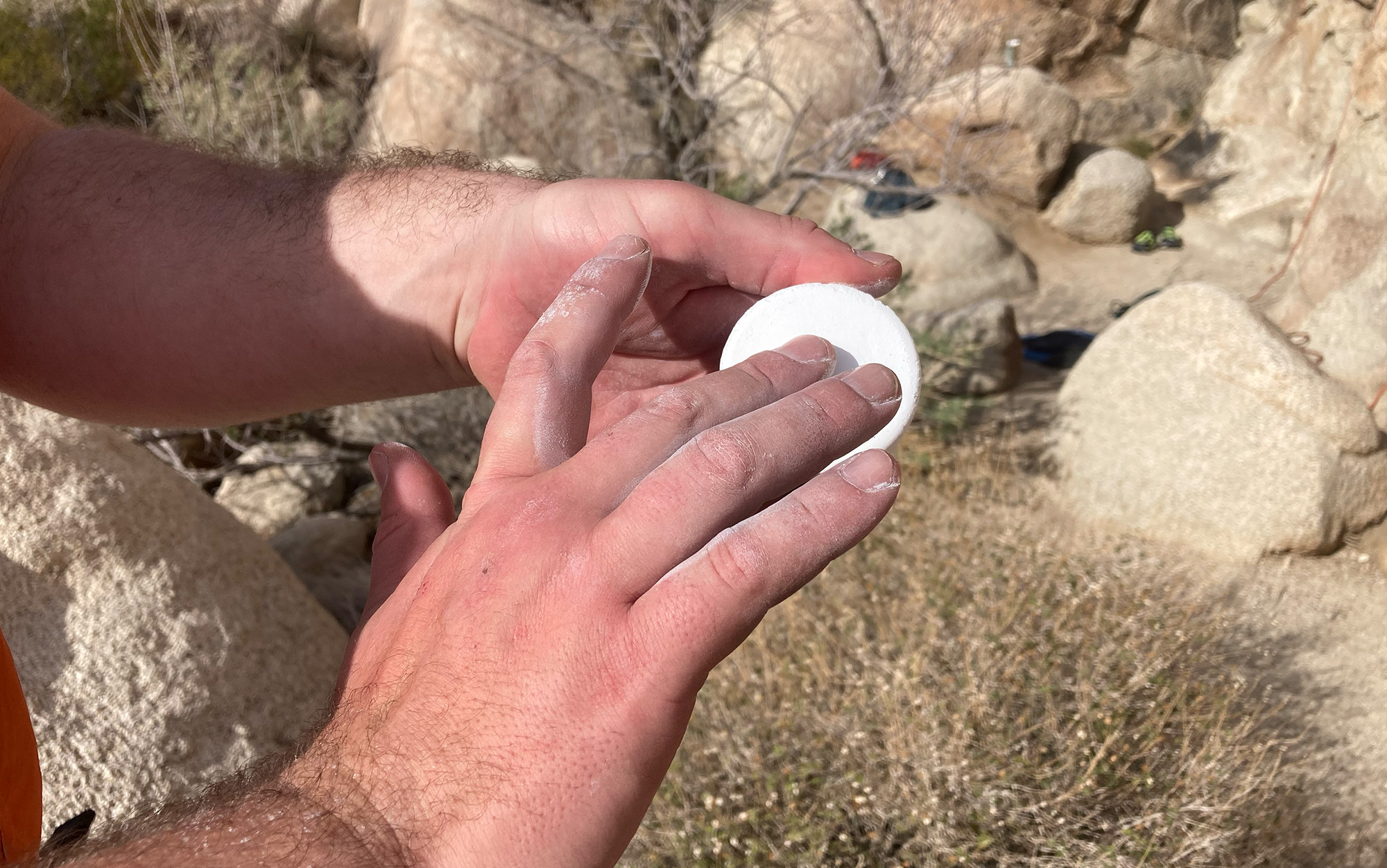
Sean McNally
The chalk discs are smaller than traditional chalk blocks so you can handle it easily when you’re rubbing it on your fingers. They also seem to be more durable than other blocks on the market so they don’t crumble as much. This reduces the amount of chalk you’re wasting or putting into the air and makes them a little easier to take with you to climbing areas. The Pringles style tube that they come in is great way to protect them and their shape in a backpack or gym bag as well. I climbed one to two minutes before needing to re-chalk — more than enough time to climb a boulder problem.
Best for the Gym: Friction Labs Secret Stuff Liquid Chalk Hygienic
Key Features
- Liquid chalk
- 75ml tube
- 80 percent alcohol content
Pros
- Doubles as hand sanitizer
- No chalk dust in the air while applying
- Lasts a long time
Cons
- Expensive
- Tube is small
I remember the first rock gym I went to in the 90’s was in a garage with pea gravel on the floor, an enduring cloud of dust hanging in the air, and a thin layer of grime over every hold. It was a great place to train and matched the ethos of the times but make no mistake it was gross. These days, if a gym is managed and staffed well, the holds will be washed on a regular basis and there will be a generally clean feeling in the space. But still, hundreds if not thousands of hands and feet move across those holds in a week.
So, to introduce a little more hygiene to our gym routine, Friction Labs has liquid chalk that has 80 percent alcohol in the formula to act like hand sanitizer and reduce the spread of germs. Now we’ve already covered that I’m no scientist and this the point where I reveal that I’m also no doctor so I can’t say with certainty what germs or viruses this stuff kills. I can, however, say that it has all of the benefits of liquid chalk indoors and the performance that Friction Labs is known for. The fact that it’s made with an ethyl alcohol base makes me feel a little less yucky, too. But I still wash my hands after I go to the gym and so should you.
Best Budget Chalk: Frank Endo Block Gym Chalk
Key Features
- Chalk block
- 1 pound
- $20
Pros
- Very cheap
- Can be used as a block or loose chalk
Cons
- Crumbles easily
- Application puts lots of chalk dust in the air
Chalk for climbers is like gas for commuters. The more you do it, the more you’ll need. It’s a line item in your monthly budget and permanently part of your overhead. There’s really no way around it so sometimes you just need to find the cheapest option and go with it. I like Frank Endo Gym Chalk because you can order it by the pound for less than $20 dollars on Amazon. This is also nice because I found I was chalking up at least every one to two minutes.
Climbers have a long history of being cheap, and buying cheap chalk is an easy way for dirtbag climbers to save some pennies. As long as it does the job, increasing the friction on your sweaty finger pads, who really needs something fancy? Besides, this chalk can do it all. You can keep this chalk as a block. Or you can crumble it up and put it in a chalk bag or bucket. You can fill a sock with it too. Hey, this stuff is so cheap you can crunch it into a fine dust and toss it in the air like Lebron James to pump yourself up before every climb.
Read Next: Best Beginner Climbing Shoes
How to Choose the Best Climbing Chalk

Sean McNally
At times, it can seem a little overwhelming looking at all the different types of chalk, the forms it comes in, and the wild fluctuations in price from product to product. In all honesty, you can’t go too wrong buying chalk but here are some things you might want to consider when making your first purchase.
Keep It Simple, Then Experiment
Buy whatever chalk is easiest at first. Whether that’s our best overall or budget pick, or just whatever is on the shelf at your rock gym, get some chalk and go climbing. As you climb more and more, you may decide you like the different application methods, consistencies, or brands detailed here.
Rules and Regulations
There are times when there might be a policy in place around what kind of chalk you can use at a certain climbing area. This is most common in indoor rock gyms where there might be a “no loose chalk” policy or a “liquid chalk only” policy to cut down on the chalk in the air. In some outdoor climbing areas there are rules that require special chalk that matches the color of the rock or there might be a rule against using chalk entirely. If you’re going to be spending a lot of time climbing in a place like that, it’s worth figuring that out and letting it guide your purchase.
Type of Climbing
The type of climbing you’re going to be doing will also be a determining factor in the application method you want. If you’re bouldering, you’ll be climbing for short periods of time so your application can be more specific and involved. Whereas if you’re climbing longer roped climbs or multipitch routes, you might need to reapply while you’re mid-route hanging by one arm so your application method will need to work with a chalk bag around your waist.
FAQs
This one is just a matter of preference. Most people like some chunks of chalk in their bag because it gives your fingers something to grab and feel. It’s more satisfying when there’s variety in texture and consistency.
It makes sense to be nervous about carrying a bag of white powder through airport security. But I can tell you that I’ve done this multiple times with no issue. The FAA also doesn’t say anything about chalk not being allowed so until they do, we’re in the clear to carry on our chalk bags.
Use just enough to keep your fingers from slipping off the climbing holds. Too much chalk caked on your fingers can actually interfere with your ability to hold on by muddying the contact point between your skin and the rock. So use whatever it takes to dry the oils on your skin and no more. You can even blow on your fingers after chalking up to remove any excess dust lingering on your skin.
Final Thoughts
Even though chalk has gotten more niche with fancier packaging in recent history, it’s still just chalk and it’s only meant to keep your sweaty fingers dry. Luckily, all chalk will do that pretty well. But the nice thing about having all these different styles of chalk to choose from is that now climbers can go out and find what works best for them and dial in their preferences. If you have something between your skin and the rock that feels good, your climb will feel good.
- Best Overall: Metolius Refillable Super Chalk Sock
- Best Loose: Friction Labs Unicorn Dust
- Best Liquid: Ocun Liquid Chalk
- Best Block: Friction Labs Chalk Disks
- Best for the Gym: Friction Labs Secret Stuff Hygienic
- Best Budget: Frank Endo Block Chalk
